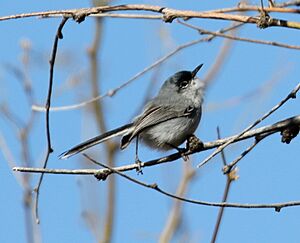Black-capped gnatcatcher facts for kids
Quick facts for kids Black-capped gnatcatcher |
|
|---|---|
 |
|
| Male | |
| Conservation status | |
| Scientific classification | |
| Genus: |
Polioptila
|
| Species: |
nigriceps
|
 |
|
The black-capped gnatcatcher (Polioptila nigriceps) is a small, active songbird. It belongs to the gnatcatcher family, Polioptilidae. You can find this bird in parts of Mexico and sometimes in the United States.
Contents
About This Bird's Family
Scientists classify living things into groups. The black-capped gnatcatcher is sometimes thought to be the same as the white-lored gnatcatcher. But scientists usually recognize them as different. There are two main types, or subspecies, of the black-capped gnatcatcher.
What Does It Look Like?
The black-capped gnatcatcher is a tiny bird. It is about 10 to 12 centimeters (4 to 5 inches) long. It weighs only 5 to 8 grams (less than an ounce)! That's about as much as two pennies.
Adults have blue-gray feathers on their backs. Their bellies are white. They have a long, thin beak and a long black tail. The outer feathers of their tail are mostly white.
Male gnatcatchers look special during breeding season. They have a shiny black cap on their heads. Females have gray upper parts. They look similar to males when they are not breeding. This bird looks very much like the black-tailed gnatcatcher.
Where Does It Live?
You can find the black-capped gnatcatcher mostly in western Mexico. This includes areas from central Sinaloa south to Colima. One type of this bird also lives in eastern Sonora south to northern Sinaloa.
Sometimes, these birds nest just across the U.S. border. This happens in the Madrean sky islands area of southern Arizona.
What Kind of Places Do They Like?
In the northern parts of its home, this bird lives in mesquite thickets. These are often near riverside areas where water is found. Farther south, it lives in dry, thorny bushes and woodlands. It usually lives in places below 500 meters (1,600 feet) high.
These birds usually do not migrate. This means they stay in the same area all year. However, some birds in the far north might move south after they have their babies.
How Does It Behave?
What Does It Eat?
Scientists believe the black-capped gnatcatcher eats arthropods. These are small creatures like insects and spiders. This is what other gnatcatchers eat. They actively search for food in trees and bushes. They pick insects off leaves. Sometimes, they fly out to catch insects in the air.
How Does It Raise Its Young?
The black-capped gnatcatcher's breeding season is from March to June. The last young birds leave the nest in July.
Their nest is a small cup shape. It is made of twigs stuck together with spider silk. The inside is lined with soft materials. They place their nests on small branches of low trees or bushes. A female usually lays four eggs.
Sometimes, another bird called the brown-headed cowbird lays its eggs in their nests. This has been seen in Jalisco.
What Sounds Does It Make?
The black-capped gnatcatcher has a complex and long song. You can listen to an example here: [1]. It also makes a "mewing" call. This call is sometimes repeated: [2].
How Is Its Population Doing?
The IUCN (a group that checks how animals are doing) says the black-capped gnatcatcher is of "Least Concern." This means it is not currently in danger of disappearing.
However, the areas where these birds live are at risk. This is because of farming and cattle grazing. These activities can change the bird's natural home.


